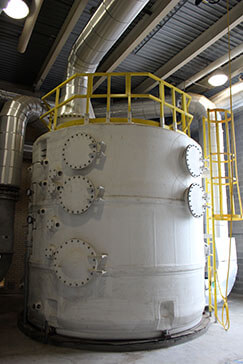
Mercury emissions can result from a wide range of sources and are drawing increasing attention from federal and state regulators. Mercury is a neurotoxin, and according to the World Health Organization, exposure to even small amounts of mercury can cause serious health problems. Excluding large power plants, sources of airborne mercury emissions include:
- Wastewater treatment plants—sewage sludge incinerators
- Municipal, medical, and hazardous waste incinerators
- Utility boilers and other small coal-fired boilers
- Gold production
- Silver, antimony and other metal production
- Waste-to-energy plants
- Other industrial exhaust streams
APC’s team has substantial depth of experience with removing of mercury from gas streams, including in a variety of production processes and air emission control applications. The most challenging applications performed to date are for removal of mercury from natural gas in the process of LNG production, where very high gas pressures are encountered (700-2,000 psi), and extremely low residual mercury concentrations– 0.01 µg/Nm3 or lower– are required. Required mercury removal rates on the order of 99.99%, slow diffusional kinetics due to high gas pressures, and competition from C3 and heavier hydrocarbons in the natural gas make these applications the most challenging mercury removal applications anywhere, and APC’s team has worked on many successful LNG mercury removal projects. APC also has furnished numerous mercury control systems to the gold industry, antimony industry and for sewage sludge incinerators.
Options available for mitigating airborne mercury emissions include activated carbon adsorption beds and powdered activated carbon injection systems.
APC’s MercPure Fixed Bed (FB Series) systems provide the highest removal efficiencies for mercury emissions using fixed adsorption beds of specialty activated carbon media. APC is media-independent and will select the best media available on the market for the application considering cost, performance, and bed longevity. APC offers full gas pre-conditioning systems including multiple options to protect the carbon bed from particulate fouling, such as its unique Ultra High-Efficiency Filter (UHF®) unit, which can precede the adsorption vessel to remove ultra-fine condensed (liquid-phase) and solid particulate, greatly extending the carbon media bed life and also allowing continuous mercury removal at high efficiency. Mercury emission removal efficiencies by APC MercPure FB systems are commonly in the range of 99.9% or higher as measured through Owner compliance tests.
APC’s MercPure powdered activated carbon (PAC Series) injection systems include carbon metering and injection systems, interconnecting ductwork and piping, and downstream fabric filter to deliver mid to high removal efficiencies (up to 90%).
To learn more about mercury emissions solutions, contact the APC Technologies team today.

